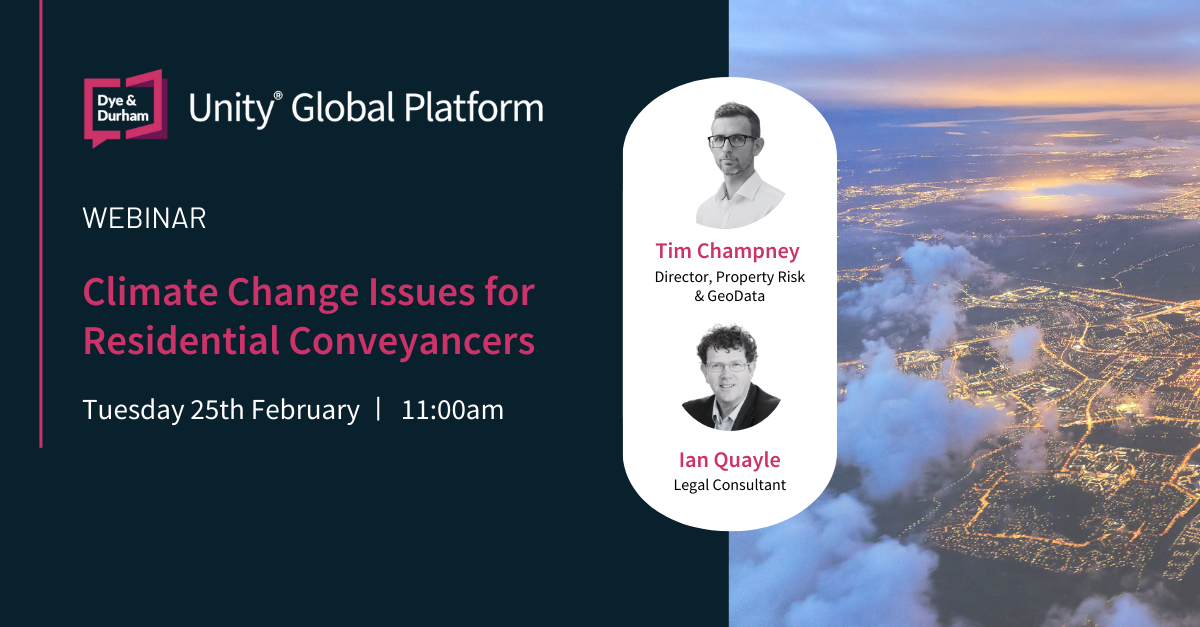By: Tim Champney, Director, Property Risk & GeoData
In recent years, climate change has shifted from an abstract concern to a real, reportable risk in property transactions. It’s no longer a question of if this information is needed but how conveyancers can provide it clearly and responsibly.
With new Law Society guidance expected in the near future, understanding your role – and limitations – when it comes to climate risk is essential.
So, what’s changing?
The Law Society’s 2023 guidance introduced the concept of physical, transitional, and liability climate risks in legal practice. The upcoming Practice Note is likely to build on this, providing more specific advice on how and when climate reports should be used in conveyancing, what they might cover, and how solicitors can signpost risk without stepping into advisory territory.
Some firms are already taking proactive steps by incorporating climate searches into their due diligence workflows. Others are waiting for clearer direction. But with 1 in 6 homes already at flood risk, and subsidence, heat stress and coastal erosion risks predicted to rise significantly by 2050, waiting may no longer be an option.
The evolving duty of care
The conveyancer’s role is not to interpret climate science or predict the specific evolution of environmental risks , however conveyancers do have a duty to highlight known or foreseeable risks, and to inform clients of the availability of relevant reports.
As Ian Quayle, a leading commentator on the Law Society guidance, puts it: “It would be a brave firm to ignore or fail to recommend a climate report in 2025.”
In practice, this means:
- Ensuring Clients are made aware of the availability of environmental searches that incorporate climate analysis (such as our new EnviroAssure or Enviro360™);
- Being upfront about what’s included, and importantly what is not;
- Avoiding direct interpretation, and instead signposting clients to appropriate specialists.
You can’t know exactly what the future will hold, but you can protect clients by showing them the tools that help them make the best informed decisions.
Our ClimateCheck™ data, which features within both EnviroAssure and Enviro360, is making it easier to present climate risks in a way that is:
- Clear: With an at-a-glance summary showing if risk is expected to increase by 2050;
- Consistent: Based on a single emissions pathway (RCP4.5), giving a coherent outlook across all physical perils – and focusing on the most probable scenario;
- Actionable: Includes practical next steps and recommendations for the buyer or homeowner to digest without requiring legal professionals to advise.
These insights are available exclusively through our new environmental reports, which provide today’s risk picture as well as tomorrow’s trajectory, in one unified document.
Climate due diligence is here to stay
We’ve seen it before: once seen as optional, environmental reports are now standard. Climate risk is following a similar path. Whether it’s identifying flood risk, assessing future subsidence exposure, or anticipating energy efficiency standards, these risks will increasingly shape lending decisions, insurance policies, and even buyer sentiment.
Being able to demonstrate that you’ve flagged climate issues (even if your client chooses not to act on them) is a vital step in limiting your own risk too.
As the new guidance lands, the best position to be in is one of preparedness. Get in touch with our team to help you and your firm stay one step ahead.

About Tim ChampneyTim is a Chartered Environmental professional, an associate member of the Royal Institution of Chartered Surveyors (RICS), and a legal technology services expert. His focus is on managing risks and providing solutions for the sale, acquisition, management and development of land and property. Tim’s background is in environmental consultancy with expertise in risk assessments for property transactions and developments. He has worked on projects from small sites to multimillion-pound developments and has regulatory experience as a Local Authority practitioner. He also has a background in environmental insurance as both a broker and underwriter. |
Related Article: Summarising the Law Society’s new Practice Note on Climate Risk and Property
Go to Media





